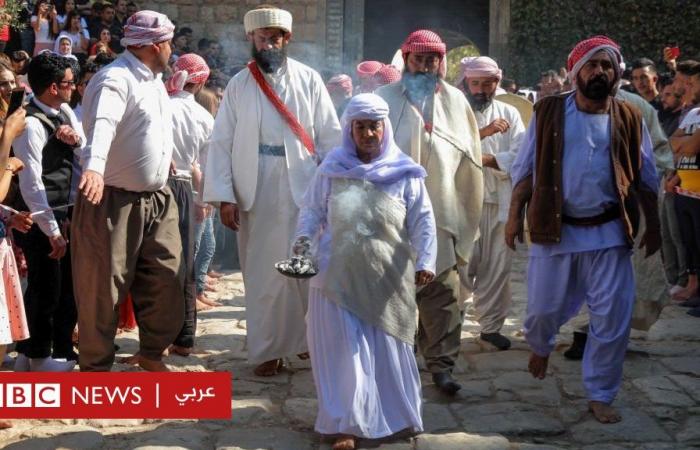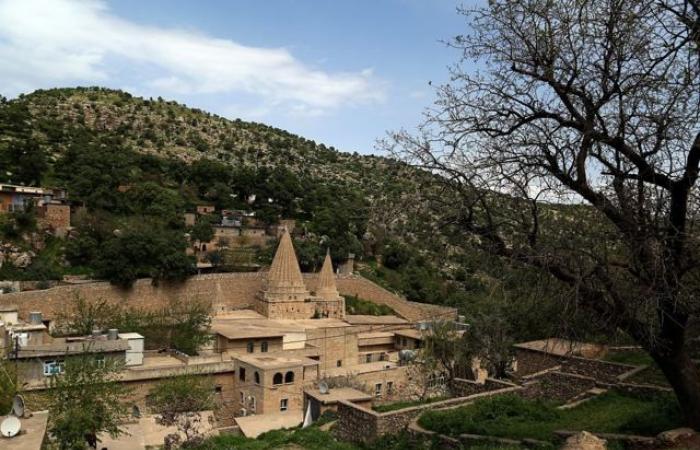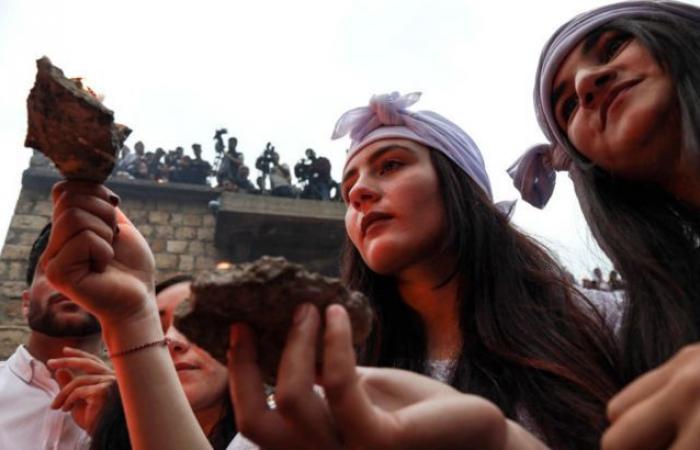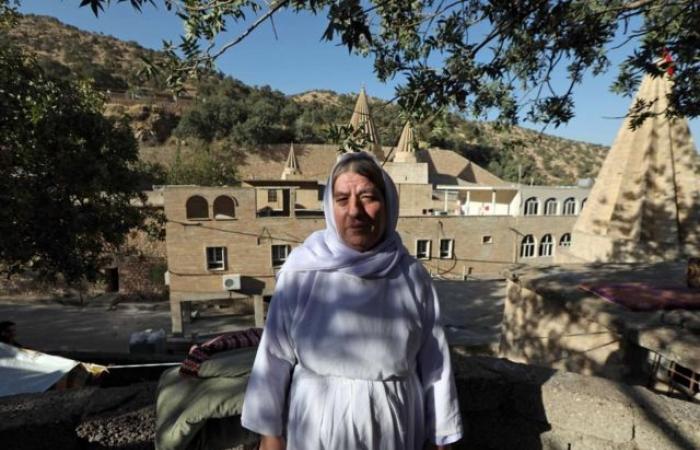- Sanaa El-Khoury
- Religious affairs correspondent
43 minutes ago
Image Released, SAFIN HAMED
During the celebration of the festival last year with Baba Gawish, guardian of the Lalish Temple
More than once, Murad performed Hajj ceremonies at the Lalish Temple, the holiest of religious shrines for the Yazidis. “I used to follow the steps I learned from my mother, so I could take a shower, and wear clean clothes in respect of the sanctity of the shrine,” he tells us via Twitter.
This year, the young Iraqi displaced will not visit Lalish, during the collective Eid, or the Hajj season for followers of the Yazidi religion, which begins on October 6 of each year and continues until the 13th of it.
This holiday represents the most prominent Yazidi religious occasion, as pilgrims visit the shrine of the prominent religious figure in their history, Uday bin Musafir, located in Lalish, east of Dohuk, in Iraqi Kurdistan.
Murad says: “Every time I visited Lalish during the collective festival, I felt endless joy from the beginning of the ceremony until its end, and my psychological comfort accompanied me, to the sounds of spiritual music that reached the ears of every visitor.”

Image Released, Anadolu Agency
Sheikh Uday bin Musafir Umayyad tomb in Lalish
This year, the Corona epidemic prevented the revival of the annual collective rituals, in addition to the death of Khartu Haji Ismail, the Pope of the Sheikh of the Yazidis in Iraq and the world, that is, the supreme religious authority for followers of the religion, at the beginning of this month.
Baba Sheikh passed away at the age of 87, and he was known for his great influence on the Yazidi community during the years following the genocide in Mount Sinjar (or Shinkal, as the Yezidis pronounce it), in 2014.
Yazidi tweet Monty Ibrahim Baba Sheikh describes that he was “humble and loving, and he had a personality unparalleled”. He added, “The most important decision he took after the genocide was his recognition of the right of every Yezidi woman who returns from the hands of ISIS to embrace among her family. He treated her as if she had not gone kidnapped, which facilitated their integration into society and their marriage to Yazidis, unlike what was happening in the past.”
Activist and journalist Ibrahim Al-Yazidi narrates about the influence of Baba Sheikh in the issue of the survivors, as “he poured water on their heads from the sacred water spring” Kania Spi “(the white eye) in the Lalish Temple, so that they would not feel frustrated and calm their souls.
The Yazidis have several feasts throughout the year, indicating their close association with nature. The most prominent of these holidays is the Red Wednesday or “Sri Sal” in April, during which it celebrates the season of fertility and the renewal of nature, and “Jamaia Shekhadi” or collective, which is their holiest holiday, and they celebrate it in the midst of the year and the beginning of autumn, which is a preparation for winter and rain.
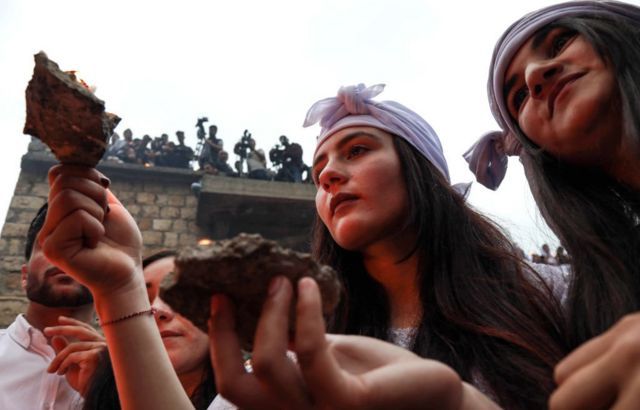
Image Released, SAFIN HAMED
Monty Ibrahim says: “Lalish is the holiest place on earth for the Yazidis, and it contains the tombs of the righteous Yazidis and the“ white eye ”where children baptize. During the past years, Lalish used to visit during the 7-day Hajj season, about 35,000 people a day.
The Yazidis were cut off from performing their rituals after the genocide at the hands of the “Islamic State” in 2014, for a short period, and they were cut off this year also due to the epidemic.
The ritual lasts for seven days, and each day includes different traditions and prayers, the most prominent of which is what is known as the ritual of heaven, and is performed every evening. Also among the rituals is the baptism of the wells, which are long fabrics dipped in holy water, and are hung at the entrance to the shrine. Likewise, the Qabag ritual means taking a calf from the door of the main temple to the shrine of Sheikh Shishmas.
There is also a special dance that the Yazidis perform on their holidays, and it is called the Kovand dance, an expression of joy in circling, and its steps and rows are similar to the dance of the Dabkeh.

Image Released, Chris McGrath
One of the servants of the holy shrines in Lalish cleans the place after the Hajj season in 2016, near a model attached to it with fabrics to indicate wishes
Music plays an important role in the Yazidis’ pilgrimage to Lalish, as there are no sacred texts of their faith, but the prayers and religious stories were passed down through the generations. A special class of Yazidi clerics, known as the Qawwalis, are responsible for preserving these prayers and passing them on from generation to generation. And every feast, he echoes the sacred texts, and accompanies them by playing the tambourine and the flute.
Among those prayers is what Murad translates to us from the Yazidi language: “Oh, my Lord, the highest of your affairs, the glory of your place and the highest of your authority, O my Lord, you are the gracious and you are the Most Merciful, O Lord, you are always the Creator and always for you befitting praise and praise.”

Image Released, SAFIN HAMED
The Yazidi tweet says: “Research on the Yazidi religion needs to delve into philosophy and eternal science and the meanings of faith in it, to gradually reach the light, and not to rely on false information.”
Among these false information is that the Yazidis worship Satan, or that their name is derived from the name Yazid bin Muawiyah. However, the followers of the religion, with their exposure to massacres throughout history, are closed to their beliefs, and they avoid transmitting them to others, and it is a non-missionary religion that does not accept new converts, and Yazidis are not allowed to marry people of other religions.
Historians disagree about the source of the Yazidi religion, but it is believed that it was the religion of the Kurds before Islam, and it has influences from the ancient religions of Iraq, and influences of Zoroastrianism. It is believed that the most prominent figure in its history, Sheikh Uday bin Musafir, introduced to it mystical influences.

Image Released, SAFIN HAMED
A Yazidi woman during the Hajj season to Lalish last year
Yazidis pray five times a day, are kissed by the sun, and they believe that they are the children of the first human, Adam. The Yezidi creation myth believes there is one god (Khudi), the creation of the world, and seven angels, whose leader is a king peacock. Followers of this religion believe that the Creator does not interfere in the affairs of humanity and the universe, but rather entrusted their affairs to King Peacock.
Peacock Malik is considered to be the embodiment of the Creator’s spirit in the Yazidi beliefs, and it is confused with Satan in the Abrahamic religions, because the religious legend says that Peacock refused to prostrate to Adam, because he only bows down to God. Note that the term “Satan” is considered a great insult to the Yazidis, as it is related to imprecise concepts about them.

Image Released, NurPhoto
Baba Sheikh Khartu Haji Ismail, who passed away early this month
The Yazidis separate the religious leadership represented by Baba Sheikh, and the civilian leadership represented by the Emir. The position of Prince Hazem bin Tahseen Bey Saeed is currently held, and he was chosen in 2019 to succeed his father, Tahseen Bey. The religious leaders and the emir will meet to choose a new Pope to succeed the late religious leader.
Yazidi society is based on special class divisions, it imposes respect for it, and intermarriage is forbidden between its members. The upper class is the Sheikh class, and it is believed that it descends from the Six Angels, and the Bir class and descends from Bir Alaa, one of the companions of Uday bin Musafir, and the Murid class, and represents the majority of Yazidis.
Yazidi social traditions are based on raising children morally, based on religious heritage, and journalist Ibrahim Al-Yazidi describes his group as “a component of peace, who have always been a support for their neighbors.”
Over the years, the Yazidi community has witnessed a gradual opening up, as a visit to the Lalish Temple has become available to everyone, and is not restricted to followers of the religion only … Visiting it may be a unique spiritual experience, were it not for the Corona epidemic.
These were the details of the news Corona virus disrupts the pilgrimage of the Yazidis: There are no... for this day. We hope that we have succeeded by giving you the full details and information. To follow all our news, you can subscribe to the alerts system or to one of our different systems to provide you with all that is new.
It is also worth noting that the original news has been published and is available at saudi24news and the editorial team at AlKhaleej Today has confirmed it and it has been modified, and it may have been completely transferred or quoted from it and you can read and follow this news from its main source.

